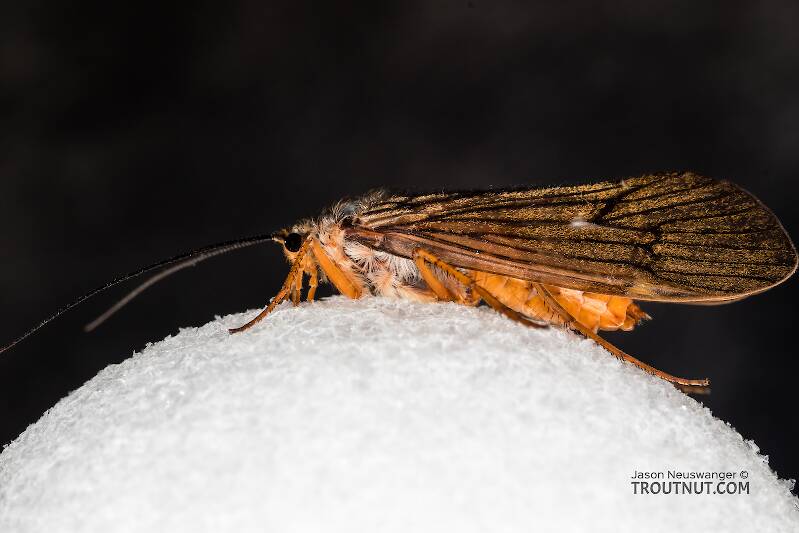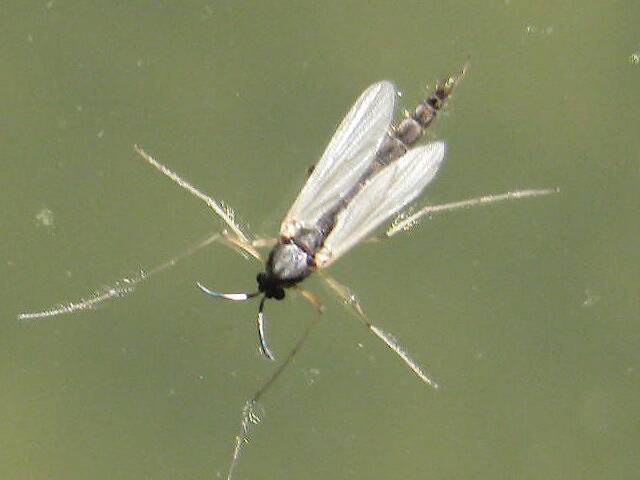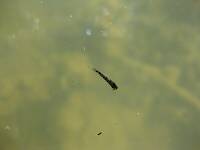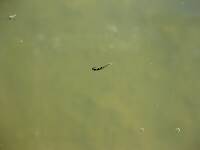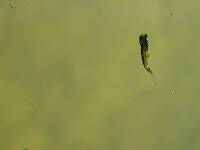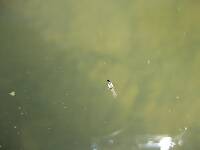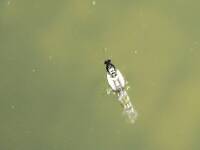
Hex Mayflies
Hexagenia limbata
The famous nocturnal Hex hatch of the Midwest (and a few other lucky locations) stirs to the surface mythically large brown trout that only touch streamers for the rest of the year.
Featured on the forum

It's only barely visible in one of my pictures, but I confirmed under the microscope that this one has a prosternal horn and the antennae are mid-way between the eyes and front of the head capsule.
I'm calling this one Pycnopsyche, but it's a bit perplexing. It seems to key definitively to at least Couplet 8 of the Key to Genera of Limnephilidae Larvae. That narrows it down to three genera, and the case seems wrong for the other two. The case looks right for Pycnopsyche, and it fits one of the key characteristics: "Abdominal sternum II without chloride epithelium and abdominal segment IX with only single seta on each side of dorsal sclerite." However, the characteristic "metanotal sa1 sclerites not fused, although often contiguous" does not seem to fit well. Those sclerites sure look fused to me, although I can make out a thin groove in the touching halves in the anterior half under the microscope. Perhaps this is a regional variation.
The only species of Pycnopsyche documented in Washington state is Pycnopsyche guttifera, and the colors and markings around the head of this specimen seem to match very well a specimen of that species from Massachusetts on Bugguide. So I am placing it in that species for now.
Whatever species this is, I photographed another specimen of seemingly the same species from the same spot a couple months later.
I'm calling this one Pycnopsyche, but it's a bit perplexing. It seems to key definitively to at least Couplet 8 of the Key to Genera of Limnephilidae Larvae. That narrows it down to three genera, and the case seems wrong for the other two. The case looks right for Pycnopsyche, and it fits one of the key characteristics: "Abdominal sternum II without chloride epithelium and abdominal segment IX with only single seta on each side of dorsal sclerite." However, the characteristic "metanotal sa1 sclerites not fused, although often contiguous" does not seem to fit well. Those sclerites sure look fused to me, although I can make out a thin groove in the touching halves in the anterior half under the microscope. Perhaps this is a regional variation.
The only species of Pycnopsyche documented in Washington state is Pycnopsyche guttifera, and the colors and markings around the head of this specimen seem to match very well a specimen of that species from Massachusetts on Bugguide. So I am placing it in that species for now.
Whatever species this is, I photographed another specimen of seemingly the same species from the same spot a couple months later.

Troutnut is a project started in 2003 by salmonid ecologist Jason "Troutnut" Neuswanger to help anglers and
fly tyers unabashedly embrace the entomological side of the sport. Learn more about Troutnut or
support the project for an enhanced experience here.
This topic is about the Insect Order Trichoptera
Some say caddisflies are even more important than mayflies, and they are probably right. The angling world has taken a while to come to terms with this blasphemy. Caddis imitations are close to receiving their fare share of time on the end of the tippet, but too many anglers still assume all caddisflies are pretty much the same.Caddis species actually provide as much incentive to learn their specifics as the mayflies do. There is just as much variety in their emergence and egg-laying behaviors, and as many patterns and techniques are needed to match them. Anglers are hampered only by the relative lack of information about caddisfly behavior and identification.
Example specimens
PaulRoberts on Jan 27, 2011January 27th, 2011, 8:56 am EST
It's tough to do both. It's the "10,000 hours" thing (Malcolm Gladwell). I found I could only do both justice without a family and a patient boss/coworkers (helps to be able to work at any hour day or night). I prefer to do. It's the healthier alternative to boot.
Entoman on Jan 27, 2011January 27th, 2011, 11:56 am EST
Paul and Spence - My "seperating fly specs from the pepper" regarding analogies aside, your observations are spot on (pun intended).
"It's not that I find fishing so important, it's just that I find all other endeavors of Man equally unimportant... And not nearly as much fun!" Robert Traver, Anatomy of a Fisherman
RalphC on Mar 4, 2011March 4th, 2011, 4:41 am EST
I just stumbled on this thread and thought I'd add a couple of comments. A reference was made to my video Bugs of the Underworld and the author identified the emerging caddis pupa as a Hydropsychid. It is actually a Banksiola crotchi, one of the Phryganeidae. This section was filmed in British Columbia. I chose these guys to film because they are huge - nearly two inches, and they emerge VERY slowly which makes them ideal for studying the emergence behavior on film. They do not form a bubble, but have extremely strong swimmerets they use to stroke and swim to the surface.
The still photograph is a caddis pupae in Manzanita Lake in N. California. I am not sure of the species. It just popped up out of the weeds and swam around in a few lazy circles then went to the surface and emerged. It was the only caddis of the day. Pure luck to get him. When he (she?) first came out of the weeds it was solid brown, but very quickly two bulges appeared on his thorax and expand with air. The tight cuticle both reflected the light when viewed from above and sparkled with an inner glow when seen in profile and from below. The cuticle is pretty transparent and easily lets the light pass.
MANY caddis form these bubbles under the cuticle, but just as many don't. Gary's book Caddisflies is fairly accurate when he describes which species to imitate with sparkle yarn and which species to not use sparkle yarn (Antron).
Where I disagree with Gary is how Antron works. The photos in his book are taken of flies that were apparently carefully placed in the water. In real fishing conditions that simply doesn't happen. The shear force of the fly going through the film strips any bubbles that might cling to the Antron. Underwater, Antron is rather sparkly and makes a nice effect, but not due to entrained air. I much prefer to coat my nymphs in a dessicant powder. It perfectly imitates the diving ovipositing adults and somewhat imitates the pupa. Bead heads make great pupa imitations when mimicking the air filled caddis species. Hope that helps.
Ralph Cutter
cutter@flyline.com
www.flyline.com
The still photograph is a caddis pupae in Manzanita Lake in N. California. I am not sure of the species. It just popped up out of the weeds and swam around in a few lazy circles then went to the surface and emerged. It was the only caddis of the day. Pure luck to get him. When he (she?) first came out of the weeds it was solid brown, but very quickly two bulges appeared on his thorax and expand with air. The tight cuticle both reflected the light when viewed from above and sparkled with an inner glow when seen in profile and from below. The cuticle is pretty transparent and easily lets the light pass.
MANY caddis form these bubbles under the cuticle, but just as many don't. Gary's book Caddisflies is fairly accurate when he describes which species to imitate with sparkle yarn and which species to not use sparkle yarn (Antron).
Where I disagree with Gary is how Antron works. The photos in his book are taken of flies that were apparently carefully placed in the water. In real fishing conditions that simply doesn't happen. The shear force of the fly going through the film strips any bubbles that might cling to the Antron. Underwater, Antron is rather sparkly and makes a nice effect, but not due to entrained air. I much prefer to coat my nymphs in a dessicant powder. It perfectly imitates the diving ovipositing adults and somewhat imitates the pupa. Bead heads make great pupa imitations when mimicking the air filled caddis species. Hope that helps.
Ralph Cutter
cutter@flyline.com
www.flyline.com
PaulRoberts on Mar 5, 2011March 5th, 2011, 1:38 am EST
Thanks for chiming in Ralph. The images I've seen of your desicant doused Bird's Nest looks like images I have of adult Hydropsychids underwater -coated with quicksilver.
Again, thanks for visiting, and thanks for all the work you've done to chip away at the REALLY important mysteries of life lol.
Again, thanks for visiting, and thanks for all the work you've done to chip away at the REALLY important mysteries of life lol.
PaulRoberts on Mar 26, 2012March 26th, 2012, 3:29 pm EDT
A while back, when I posted the above question, I also posed it to Gary Borger on his site. Apparently he'd responded:
http://www.garyborger.com/2010/01/07/caddis-pupa-husk/
http://www.garyborger.com/2010/01/07/caddis-pupa-husk/
Taxon on Mar 26, 2012March 26th, 2012, 4:40 pm EDT
Illuminating information, Paul. Thanks for sharing.
Crepuscular on Mar 26, 2012March 26th, 2012, 4:42 pm EDT
Great stuff gentlemen! Really cool information.Thank you
Martinlf on Mar 26, 2012March 26th, 2012, 6:31 pm EDT
It's encouraging to see facts separated from suppositions, since far too often suppositions are put forth so confidently that they are taken as fact. Thanks, Paul.
"He spread them a yard and a half. 'And every one that got away is this big.'"
--Fred Chappell
--Fred Chappell
PaulRoberts on Mar 27, 2012March 27th, 2012, 6:42 am EDT
I'm still not sure what the facts are. Not 'til I don scuba gear and see for myself I suppose. Or...get my river tank back in action.
Entoman on Mar 27, 2012March 27th, 2012, 11:49 am EDT
Paul,
FWIW - The link you provided points out what I have believed/observed for some time. I haven't done any scuba, but I have done some Summer snorkling and observed caddis pupa many times. I have NEVER observed quicksilver pupa. The halo pupa is my best attempt at imitating the sheathed glistened look. Sometimes there is a bit of gas (fluid) build-up near the head as the cuticle loosens that can appear as a brighter spot, perhaps explaining the effectiveness of some bead head patterns like the Poopah.
FWIW - The link you provided points out what I have believed/observed for some time. I haven't done any scuba, but I have done some Summer snorkling and observed caddis pupa many times. I have NEVER observed quicksilver pupa. The halo pupa is my best attempt at imitating the sheathed glistened look. Sometimes there is a bit of gas (fluid) build-up near the head as the cuticle loosens that can appear as a brighter spot, perhaps explaining the effectiveness of some bead head patterns like the Poopah.
"It's not that I find fishing so important, it's just that I find all other endeavors of Man equally unimportant... And not nearly as much fun!" Robert Traver, Anatomy of a Fisherman
Oldredbarn on Mar 27, 2012March 27th, 2012, 12:17 pm EDT
Great discussion here fellas!
Our eyes can deceive us and our brain trys to turn these deceptions in to some kind of patterned truth...We are slaves to our senses...:)
Whatever this may mean...
Spence
Our eyes can deceive us and our brain trys to turn these deceptions in to some kind of patterned truth...We are slaves to our senses...:)
Whatever this may mean...
Spence
"Even when my best efforts fail it's a satisfying challenge, and that, after all, is the essence of fly fishing." -Chauncy Lively
"Envy not the man who lives beside the river, but the man the river flows through." Joseph T Heywood
"Envy not the man who lives beside the river, but the man the river flows through." Joseph T Heywood
Entoman on Mar 27, 2012March 27th, 2012, 12:18 pm EDT
Wax on, wax off... :)
"It's not that I find fishing so important, it's just that I find all other endeavors of Man equally unimportant... And not nearly as much fun!" Robert Traver, Anatomy of a Fisherman
Oldredbarn on Mar 27, 2012March 27th, 2012, 12:25 pm EDT
Wax on, wax off... :)
Ha! Ha! Exactly! I have just discovered that I've gone over 1,300 posts and you are somehow behind me...I think I'll pull over to the side of the road and let you catch up, Kimosabe...;)
Spence
"Even when my best efforts fail it's a satisfying challenge, and that, after all, is the essence of fly fishing." -Chauncy Lively
"Envy not the man who lives beside the river, but the man the river flows through." Joseph T Heywood
"Envy not the man who lives beside the river, but the man the river flows through." Joseph T Heywood
Falsifly on Mar 27, 2012March 27th, 2012, 12:26 pm EDT
We are slaves to our senses...:)
The truth will set us free.
Falsifly
When asked what I just caught that monster on I showed him. He put on his magnifiers and said, "I can't believe they can see that."
When asked what I just caught that monster on I showed him. He put on his magnifiers and said, "I can't believe they can see that."
Martinlf on Nov 21, 2015November 21st, 2015, 5:22 pm EST
OK, Ralph Cutter says, in a post above, some caddis do form bubbles under the cuticle. Gary Borger comments that there is no evidence for a gas bubble in caddis.
"He spread them a yard and a half. 'And every one that got away is this big.'"
--Fred Chappell
--Fred Chappell
Lastchance on Nov 22, 2015November 22nd, 2015, 4:55 am EST
I say, gas bubble or air bubble, what's the difference? It's a bubble and the veil portrays that very thing. (I couldn't think of a better word than, portray), feel free to educate me.
Lastchance on Nov 22, 2015November 22nd, 2015, 5:00 am EST
A while back, when I posted the above question, I also posed it to Gary Borger on his site. Apparently he'd responded:
http://www.garyborger.com/2010/01/07/caddis-pupa-husk/
Read this, people. So, Borger is saying only the female egg layers have a veil, sac, etc.
Wbranch on Nov 22, 2015November 22nd, 2015, 5:32 am EST
I read the link and it was very interesting. So there is an air bubble but not from what we thought were ascending pupa but female adults ovipositing.
Catskill fly fisher for fifty-five years.
Martinlf on Nov 22, 2015November 22nd, 2015, 9:42 am EST
Yes, though Cutter says some caddis do produce a gas bubble. From what I can tell, the issue is not clearly or fully resolved. However, we do know for a fact that LaFontaine's flies work.
"He spread them a yard and a half. 'And every one that got away is this big.'"
--Fred Chappell
--Fred Chappell
PaulRoberts on Nov 23, 2015November 23rd, 2015, 8:27 am EST
http://www.garyborger.com/2010/01/07/caddis-pupa-husk/
"Glisten" in hand is not the same as such fluid might appear under water. Water notoriously degrades light, flattening out reflections. Add depth, clouds, surface ripples, dissolved or suspended matter, and reflections erode rapidly. It would take some serious air (area) to shine. The only aquatic inverts of interest to FF's I can think of that hold that much air are diving caddis species (using the hairs on their wings and bodies), Baetis males (with folded wings), and backswimmers (on the hairs on their wing cases), all collected above the water's surface.
Gary Borger says:
Hi Paul, No one that I know of in the scientific literature has seen caddis pupa pumped full of gasses. They have seen and clearly showed that there is molting fluid between the pupal husk and the enclosed adult and that it makes the pupa glisten.
"Glisten" in hand is not the same as such fluid might appear under water. Water notoriously degrades light, flattening out reflections. Add depth, clouds, surface ripples, dissolved or suspended matter, and reflections erode rapidly. It would take some serious air (area) to shine. The only aquatic inverts of interest to FF's I can think of that hold that much air are diving caddis species (using the hairs on their wings and bodies), Baetis males (with folded wings), and backswimmers (on the hairs on their wing cases), all collected above the water's surface.
Quick Reply
Related Discussions
Topic
Replies
Last Reply
1
Jan 10, 2012
by Doublespey
by Doublespey
28
Nov 24, 2015
by Martinlf
by Martinlf


